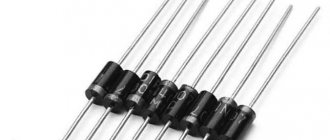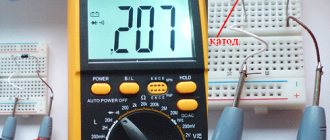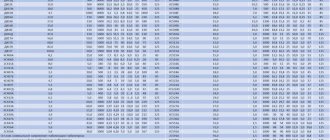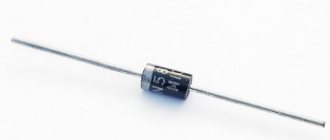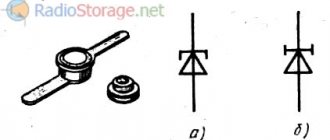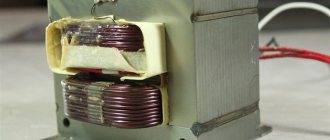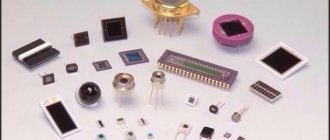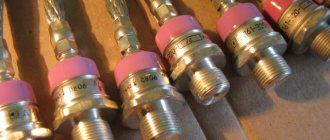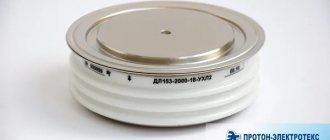- Plastic case.
- Fire resistance level 94V-0 according to Underwriters Laboratory Flammability classification.
- For surface mounting.
- The element has a small height.
- The housing design provides protection against excess tension on the leads.
- Metal-silicon transition, basic carriers are used.
- Low loss, high efficiency.
- High overload capacity.
- Low voltage drop of an open diode.
- High current resistance.
- Guardring protection (protective ring) from overvoltage.
Application area
The low recovery speed of SS14 opens up the possibility of using the element in pulsed devices for various purposes, as well as power supplies - high-frequency inverters that convert alternating voltage to direct voltage.
Due to their miniature size and housing features, diodes are widely used in various compact electronic devices with high packing density. In circuits, they protect active components from possible operating conditions such as overvoltage.
Another component of electronic gadgets where SS14 is widely used is circuits for replenishing electrical energy in smartphones, tablets, laptops and other mobile devices. Due to the low voltage drop across the open diode, their charging efficiency increases.
Application
Schottky diode
Most often, these diode components are used for rectifier purposes in switching-type power supplies. This use is possible due to the minimal restoration period for these parts. They are also mounted in the housings of transistor parts; in this case, the diodes are responsible for protecting against short circuit incidents and minimizing switching losses. Another important area of application for SS14 elements is their installation in chargers used to renew the life of smartphones, tablet computers, mp3 players and other gadgets.
Important! Exceeding the highest set reverse voltage value, even for a short time, leads to irreversible loss of performance of the diode component. The same consequences are caused by a deficiency of heat removal when operating in modes close to the limit. This is due to an uncontrolled increase in reverse electric current and subsequent excessive heating. When installing a diode in an electrical circuit, it is necessary to take these nuances into account and ensure proper operating conditions.
You can check the operation of the part using a multimeter. As with the ringing of most other diodes, here it should be set to resistance mode. Some models of devices have a special program for checking diodes; if available, you need to use it. The difference from the standard test is that since these components are mounted directly on the board, the question arises of how to carry out the procedure without desoldering, because the component body does not have connectors large enough to accommodate probes.
To carry out the test, you will need to build a special structure. The role of probes will be played by thin conductive elements: these can be sewing needles, fragments of twisted pair, or single thin conductors that are part of a complex cable. It is usually not difficult to select a suitable thickness by eye. They will need to be connected to conventional probes by soldering. Another option is to connect thin parts by soldering to a textolite fragment covered with foil and connect probes without plugs.
Important! Since these components are classified as polarized, polarity must be observed when checking. It is not difficult to navigate this, given that the cathode side is always marked in some way (usually a colored stripe) on the surface of the case.
Mechanism for checking a standard (non-smd) diode with a multimeter
Limit values and electrical characteristics
The data in the table is valid at air temperatures up to 25°C.
| Designation | Parameter | Max. | Unit change |
| VRRM | Maximum Peak Reverse Voltage | 40 | V |
| VRMS | Maximum rms voltage | 28 | V |
| VDC | Maximum blocking DC voltage | 40 | V |
| I(AV) | Maximum average rectified forward current at TA=55°C | 1 | A |
| IFSM | Peak forward pulse current | 40 | A |
| VF | Maximum instantaneous forward voltage at 1.0A current | 0,5 | V |
| IR | Maximum continuous reverse current at TA = 25°C | 0,2 | µA |
| at rated blocking DC voltage and TA = 100°C | 6 | ||
| RθJA | Typical Thermal Resistance | 88 | °C/W |
| T.J. | Operating temperature range | -65… +125 | °C |
| TSTG | Storage temperature | -65… +150 | °C |
Basic electrical parameters
Although the maximum operating temperature of the diode is 125 degrees Celsius, the parameter values indicated in the output data are valid for “room” temperature - 25 degrees. The maximum strength of the rectified electric current in this case will be 1 ampere. This value applies to the connection situation of inductors and resistor elements. With a capacitive load (capacitors), the indicator will be lower - about 0.8 amperes. The peak rectified current of diode variants from different companies can vary in the range from 30 to 60 amperes (over a time period of 8 ms). Typically for SS14 it is 40 amps.
1n5819 diode: characteristics
For reverse voltage at its peak, the permissible maximum is 40 volts. The largest drop for an open element is small - 0.5 volts. The lowest operating temperature is -65 degrees Celsius. With a frequency indicator of 1 megahertz, the part has a capacity of 50 picofarads.
Important! The average rectified voltage is always significantly less than the maximum indicated in the documents. For a given Schottky diode, this difference is approximately 1.5 times. When installing by soldering, the duration of temperature exposure should not exceed 10 seconds. The recommended temperature for the process is 260 degrees Celsius.
Imported and domestic analogues
Schottky diodes are produced by several manufacturers under the same name. These include Taiwan Semiconductor, Multicomp, Vishay Semiconductor. Therefore, you can look for a replacement for your diode in the corresponding catalogs of radio components of different brands.
The table shows possible analogues from different manufacturers. They have the same housings as the original, but may differ slightly in technical characteristics. Therefore, to ensure that replacement is possible, you must carefully study the datasheet of the analogue before the operation.
| Analogue | Reverse voltage (V) | Forward current (A) | Forward voltage (mV) |
| SS14 | 40 | 1 | 500 |
| STPS1L40A (ST) | 40 | 1 | 500 |
| MBRA140T3G (ONS) | 40 | 1 | 550 |
| STPS140A (ST) | 40 | 1 | 550 |
| MBRA140T3 (ONS) | 40 | 1 | 550 |
| SS14E-TP (MCC) | 40 | 1 | 600 |
| 10MQ040NTRPBF (VISHAY) | 40 | 1 | 540 |
| BYS10-45-E3/TR (VISHAY) | 45 | 1,5 | 500 |
| SS14-E3/61T (VISHAY) | 40 | 1 | 500 |
| B240A-E3/61T (VISHAY) | 40 | 2 | 550 |
| VS-15MQ040NTRPBF (VISH/IR) | 40 | 1,5 | 420 |
SS14 Schottky diode pinout
Technical characteristics and markings of the SS14 diode
Schottky diodes
To operate in circuits with currents of more than 1A, SR24 diodes rated for currents up to 2A are supplied from a warehouse in Moscow.
For currents up to 3A, Schottky diodes SX34 with a maximum reverse operating voltage of 40V and Schottky diodes SX36 with a maximum reverse operating voltage of 60V are supplied. Both of these diodes have an SMA package.
To dissipate high powers, Schottky diodes are supplied in SMC packages. The SK34 diode chip is similar to the SX34 3A diode, but is packaged in a larger SMC package. The same packages contain MB310 diodes with a maximum reverse operating voltage of 100V for a current of 3A and an MB510 diode also for 100V but for a current of up to 5A.
The most powerful Schottky diode supplied from the company's warehouse in Moscow is the SVC10120VB. The diode is packaged in a TO-227B SMD package and is capable of passing current up to 10A at a circuit voltage of up to 120V.
For operation in pulsed and high-frequency circuits, Schottky diodes are supplied with a standardized junction capacitance measured in several tens of picofarads. For a current of 1 Ampere, the SS1060FL diode with a maximum reverse operating voltage of 60V and the SS10100FL diode with a maximum voltage of 100V are supplied. For high currents, up to 2 A, similar diodes SS2060LHESS2060LHE and SS2100FL are supplied.
Typical performance characteristics
Rice. 1. Dependence of forward current on temperature.
Rice. 2. Dependence of forward current on forward voltage.
Rice. 3. Dependence of forward pulse current on the number of periods of frequency 60Hz.
Rice. 4. Dependence of capacitance on reverse voltage.
Analogs
As a full-fledged analogue of SS14 we can name:
- MBRA140TRzh
- STPS140A.
Also, instead of the device in question, you can install:
- CDBA140;
- FM5819;
- SK14;
- STPS1L40A.
Also, the SMAB14 diode was previously produced, which can no longer be found for sale in domestic stores. Due to the fact that products from domestic manufacturers are usually cheaper, many are interested in the question: are there domestic analogues? Unfortunately, no, so you have to look among foreign products.
Peculiarities
The Schottky junction (barrier) is structurally implemented in the form of a contact between a metal and a semiconductor; the usual semiconductor P–N structure with electron-hole conductivity is not used here; the current through the junction is formed by the majority carriers – electrons.
Diodes made using this technology are named after Walter Schottky, who first described the properties of the metal-semiconductor transition. They are characterized by low resistance in the forward direction (low voltage drop), high speed, low electrical capacitance of the junction - they can be used at high frequencies.
They also have disadvantages due to the design features: they are unstable to exceeding the maximum reverse voltage, an increase in the temperature of the crystal provokes a sharp increase in the reverse current. Semiconductors based on silicon or gallium arsenide, the main material for LEDs, are used. Metal – gold, platinum, silver. The characteristics of the product depend on the metal used.
Manufacturers and DataSheet
The diode we are considering is quite popular and is produced by many foreign companies. We list the largest of them:
- Taiwan Semiconductor Company,
- Fairchild Semiconductor,
- Vishay Siliconix
- Jinan Gude Electronic Device,
- Nanjing International Group,
- Suntan Capacitors.
In domestic stores you can most often find products from the following companies:
- Yangzhou yangjie electronic,
- DC Components,
- ON Semiconductor,
- Galaxy Semi-Conductor Holdings Limited,
- GUANGDONG HOTTECH INDUSTRIAL.
You can download the datasheet for ss14 by clicking on the manufacturer’s name.
